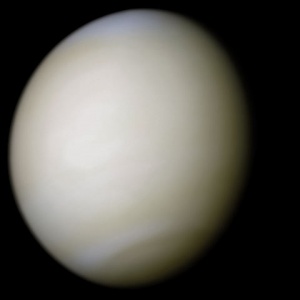Venus

Venus is the second planet from the Sun, orbiting it every 224.7 Earth days. It has the longest rotation period (243 days) of any planet in the Solar System and rotates in the opposite direction to most other planets. It has no natural satellites. It is named after the Roman goddess of love and beauty. It is the second-brightest natural object in the night sky after the Moon. As one of the brightest objects in the sky, Venus has been a major fixture in human culture for as long as records have existed. It has been made sacred to gods of many cultures, and has been a prime inspiration for writers and poets as the "morning star" and "evening star".
The Venus tablet of Ammisaduqa, believed to have been compiled around the mid-seventeenth century BCE, shows the Babylonians understood the two were a single object, referred to in the tablet as the "bright queen of the sky", and could support this view with detailed observations. The Ancient Greeks thought of the two as separate stars, Phosphorus and Hesperus. Pliny the Elder credited the realization that they were a single object to Pythagoras in the sixth century BCE, while Diogenes Laertius argued that Parmenides was probably responsible. The ancient Chinese referred to the morning Venus as "the Great White" (Tai-bai 太白) or "the Opener (Starter) of Brightness" (Qi-ming 啟明), and the evening Venus as "the Excellent West One" (Chang-geng 長庚). The Romans designated the morning aspect of Venus as Lucifer, literally "Light-Bringer", and the evening aspect as Vesper, both literal translations of the respective Greek names.
The astronomical symbol for Venus is the same as that used in biology for the female sex: a circle with a small cross beneath. The Venus symbol also represents femininity, and in Western alchemy stood for the metal copper. Polished copper has been used for mirrors from antiquity, and the symbol for Venus has sometimes been understood to stand for the mirror of the goddess. [1]
References

